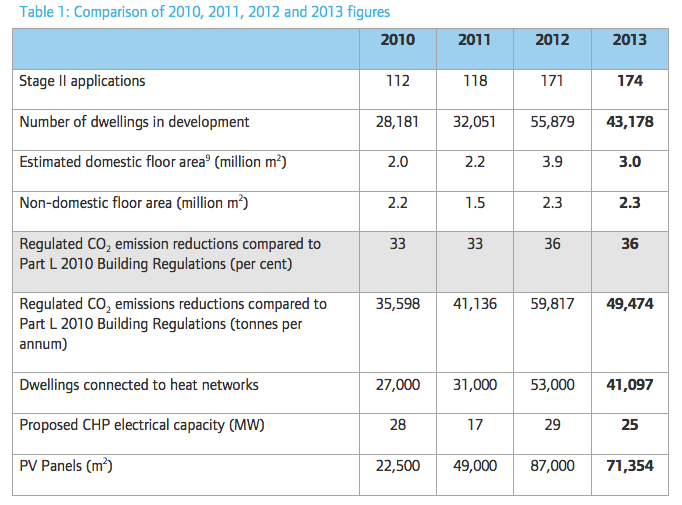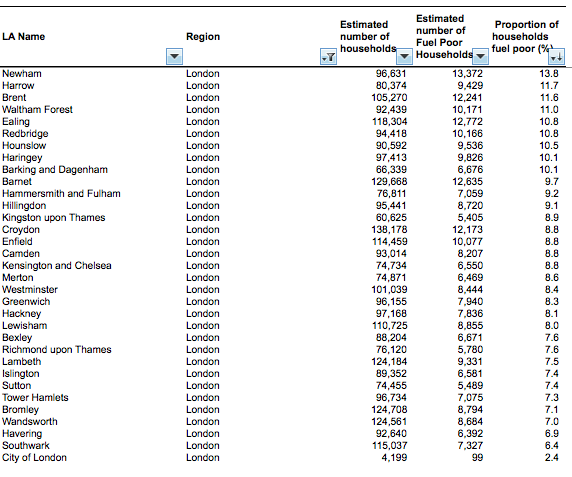Site search:
-
What’s new?
Energy for London Tags
Brent Buildings Camden Carbon Emissions CHP Cities Climate Adaptation Community Heating Community Initiatives Croydon Data DECC Decentralised Energy Distribution ECO Energy Costs Energy Efficiency Enfield FIT Fuel Poverty Funding Green Deal Hackney Haringey Housing Islington Lambeth Library Local Authorities Mayor Newham Ofgem Olympics Photovoltaics Planning RE:FIT RE:NEW Renewable Energy Retrofit Southwark Tower Hamlets Transport Waltham Forest Waste WestminsterEnergy Archives:
- February 2021 (1)
- January 2021 (15)
- December 2020 (15)
- November 2020 (9)
- October 2020 (3)
- August 2020 (5)
- July 2020 (3)
- June 2020 (4)
- April 2020 (10)
- March 2020 (5)
- February 2020 (2)
- January 2020 (3)
- October 2019 (1)
- September 2019 (4)
- August 2019 (2)
- July 2019 (1)
- August 2018 (1)
- November 2016 (8)
- October 2016 (8)
- September 2016 (2)
- August 2016 (8)
- July 2016 (14)
- April 2016 (12)
- March 2016 (16)
- February 2016 (8)
- January 2016 (4)
- December 2015 (1)
- November 2015 (1)
- October 2015 (16)
- September 2015 (3)
- June 2015 (1)
- May 2015 (1)
- April 2015 (1)
- March 2015 (1)
- February 2015 (1)
- January 2015 (1)
- December 2014 (18)
- November 2014 (4)
- August 2014 (8)
- July 2014 (7)
- June 2014 (25)
- May 2014 (8)
- April 2014 (4)
- March 2014 (12)
- February 2014 (7)
- January 2014 (13)
- December 2013 (11)
- November 2013 (15)
- October 2013 (15)
- September 2013 (18)
- August 2013 (5)
- July 2013 (20)
- June 2013 (33)
- May 2013 (8)
- April 2013 (16)
- March 2013 (25)
- February 2013 (14)
- January 2013 (20)
- December 2012 (23)
- November 2012 (23)
- October 2012 (25)
- September 2012 (14)
- July 2012 (12)
- June 2012 (43)
- May 2012 (20)
- April 2012 (8)
- March 2012 (40)
- February 2012 (39)
- January 2012 (40)
- December 2011 (22)
- November 2011 (40)
- October 2011 (33)
- September 2011 (48)
- August 2011 (40)
- July 2011 (58)
- June 2011 (41)
- May 2011 (80)
- April 2011 (38)
- March 2011 (33)
- February 2011 (25)
- January 2011 (24)
- December 2010 (3)
- November 2010 (7)
- October 2010 (6)
- September 2010 (7)
- August 2010 (1)
- July 2010 (2)
- June 2010 (4)
- May 2010 (1)
- March 2010 (3)
- February 2010 (3)
- December 2009 (5)
- November 2009 (2)
- October 2009 (3)
- July 2009 (3)
- June 2009 (1)
- April 2009 (1)
- March 2009 (1)
- February 2009 (1)
- January 2009 (1)
- December 2008 (2)
- October 2008 (1)
- September 2008 (1)
- July 2008 (1)
- March 2008 (2)
- January 2008 (2)
- October 2007 (1)
- September 2007 (3)
- July 2007 (1)
- March 2007 (1)
- February 2007 (3)
- November 2006 (3)
- August 2006 (1)
- February 2006 (1)
- May 2005 (1)
- February 2004 (1)
Energy Efficiency
Boris on energy, marmite and marmalade
August 2014: The Mayor provided the following insight in his latest #AskBoris Twitter session.
I quite liked this – and so did several others it seems – with the issue picked up in the Telegraph, Fox News,and Evening Standard.
Lewisham Free Home Energy Makeover
August 2014: Lewisham Council is looking for “a home we can use to showcase energy efficiency measures. We will install improvements worth up to £10,000 free of charge to make your home less energy hungry. This might be insulation for your walls, roof, doors or windows; more efficient lighting or heating or even renewable energy installed so you can generate your own energy. You’ll get a free assessment of your home to help you decide which measures you want installed.”
The deadline for entries is 31 August 2014.
Posted in Energy Efficiency, News
Tagged Bexley, Bromley, Energy Efficiency, insulation, Lewisham, Retrofit
Leave a comment
Energy and Climate Questions to the Mayor
July 2014: This month the Mayor has been asked questions in relation to:
Mayoral involvement with the Local Government Climate Roadmap; organisations operating at the London Sustainable Industries Park; potential for the London Pension Fund Authority (LPFA) to invest in low carbon London projects; whether Energy Performance Certificate or Green Deal assessments will be provided for homes that go through the RE:NEW programme; monitoring high energy consuming buildings in London; reductions in forecasted projections of CO2 savings in Mayor’s energy supply programme; Transport for London’s (TfL) Energy Strategy; the Mayor’s Memorandum of Understanding (MoU) with energy suppliers; visit by Mayor’s energy advisor to Camden’s biomethane refuelling station; correspondence with DCLG on the Mayor being able to set London specific energy efficiency targets in planning rules for new development; meetings with DECC over encouraging the use of solar PV on GLA land and building; new district heating network using heat from Greenwich Power Station; the low take up of ECO energy efficiency programme in London; connecting Whitehall District Heating Scheme to Pimlico District Heating Undertaking; the Mayor’s response to a recent London Solar Energy report by Green Party London Assembly member Jenny Jones; future TfL electricity costs; whether the Mayor responded to the Government’s recent solar PV consultation; concerns over government changes to the ECO as raised by the Mayor; funding for the next round of the RE:NEW programme; energy efficiency requirements in the private rented sector; monies received by the Green Bus Fund; work being undertaken to assess the economic impact to London as a result of climate change; attendance at the World Mayors Summit of Climate Change; planning offset funds; contract awarded for management of the RE:NEW programme; and if the Mayor’s High Level Electricity Working Group has considered solar PV.
Previous months questions to the Mayor can be found here.
Research Paper on Mayor’s home energy efficiency programme published
July 2014: The results of a study of the Mayor’s home energy efficiency programme, RE:NEW, has recently been published in major academic journal Energy Policy (which – for once – is freely available online!) focussing on the first major roll-out of phase of RE:NEW, delivered between July 2011 and April 2012, where 50,683 homes underwent a RE:NEW home energy visit.
The conclusions set out in the paper are quite stark and concludes that with respect to the programme’s engagement with households, that RE:NEW:
- Visits do not generate significant pro-environmental behaviour change.
- Visits do not overcome the barriers to the installation loft and wall insulation.
The paper’s author researched the delivery of RE:NEW in three inner London boroughs and provides a helpful contribution in understanding the limitations and constraints of the programme. The paper also identifies why the design of the programme may have contributed to the challenges RE:NEW faced in achieving its goals and also in engaging effectively with householders. These include:
- “The RE:NEW programme and the specification of the visit were conceived at City Hall and were based on a policy intent of reducing carbon emissions, rather than as the result of demands or expressed desire from residents. As a result, the appetite for the programme, from householders, was questionable.”
- one of the limitations of the home energy visit was the time constraint on visits. Visits generally lasted about an hour and this was due to a number of reasons. Most of the advisors were employed as contract workers and were paid a fixed price for each visit delivered…there was a focus on the number of visits delivered, rather than the length or quality of the visit.
- the short visit length meant that advisors did not have adequate time to install all of the easy measures provided during the visit.
- The effectiveness of visits, specifically in relation to encouraging the adoption of curtailment behaviours, was limited by the expertise of the ‘energy advisors’ who had inadequate training prior to delivering visits.
- over 70% of the visits to the sample groups in local authorities B and C, the householder receiving the visit was living in rented (privately, council or RSL) housing and did not have control over the potential to install further measures.
- the GLA and the local authorities were focused on achieving different outcomes from the RE:NEW visits. For the GLA, the focus of the visits was on reducing carbon emissions, whereas for the local authorities, the focus was on reducing fuel poverty, but these differing aims are not necessarily complementary
- If an impact-oriented approach is taken to reducing carbon emissions then the focus of home energy visits may better placed be on high energy consumers, who are likely to be from more wealthy neighbourhoods and home-owners who will have the control over their properties to make structural changes. Though using tax-payers money to fund such work is unlikely to be politically acceptable
Overall, the study concludes: “Negligible savings were achieved as a result of the installation of significant measures. The impact of the visit on energy and water saving behaviours were also negligible. Overall, for these households, the impact of a visit led to an estimated average reduction in annual household emissions of 3%.”
The paper notes that some of the limitations of the RE:NEW programme have been recognised, and were set out in an evaluation report published earlier this year by the GLA (see earlier post here for background and link to paper).
A third phase of the RE:NEW programme has recently been initiated by the GLA.
Posted in Energy Efficiency, News
Tagged Energy Efficiency, Fuel Poverty, Housing, RE:NEW
Leave a comment
How climate adaptation in cities creates a resilient place for business
10 July 2014: A new study by the Carbon Disclosure Project (CDP) reporting on how the “majority of the world’s major cities have disclosed that climate change presents a physical risk to the businesses operating in their cities.”
The press release sets out that CDP has “examined data from 50 cities where 78 companies have reported that they expect climate change to have a physical effect,” and the study illustrates action taken through a number of city case studies, including one looking at how London uses its planning powers.
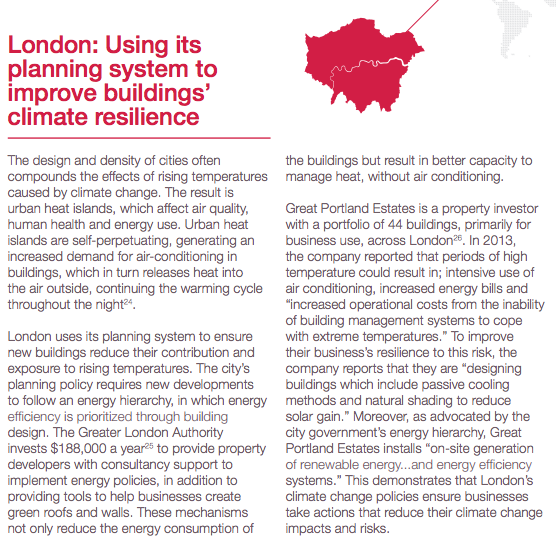 The case study states that the GLA provides “property developers with consultancy support to implement energy policies”. However, what actually happens is that expert consultancy support is brought into the GLA to provide guidance to planning officers to ensure that developers are complying with climate mitigation policies set out in London’s spatial planning strategy – the London Plan. This is fully explained in a reference actually cited in the CDP report – which links to a GLA approval document providing background details for this consultancy spend, which sets out that:
The case study states that the GLA provides “property developers with consultancy support to implement energy policies”. However, what actually happens is that expert consultancy support is brought into the GLA to provide guidance to planning officers to ensure that developers are complying with climate mitigation policies set out in London’s spatial planning strategy – the London Plan. This is fully explained in a reference actually cited in the CDP report – which links to a GLA approval document providing background details for this consultancy spend, which sets out that:
- The GLA have procured energy engineering consultancy support from 1st April 2014 to 30th March 2018, with a value of up to £440,000.
- This technical support has helped secure CO2 emissions reductions of 36% more than 2010 Building Regulations requirements for developments
- This support helps provide officers with an assessment of complex energy systems such as Combined heat and power systems, district heating network specifications, the use of heat pumps etc.
Analysis published at the end of last month by the GLA provides some detailed information on how this consultancy support has helped secure significant levels of low carbon investment in new London developments. Full details here.
Data on climate adaptation measures installed in new London development are less well documented. A recent Mayoral Question (MQ) set out an estimate on the number of green roofs installed in London. A further related MQ touch upon the Mayor’s plan to develop an interactive map on green roofs in London.
London Plan spurs on carbon savings in new developments
30 June 2014: The latest annual assessment report of energy and carbon savings secured through the Mayor’s planning requirements has just been published by the GLA.
An energy assessment is required for each planning application referable to the Mayor, setting out how the London Plan energy policies will be met within the development. Specifically, applicants are required to set out how the planning applications apply the following energy hierarchy: Be lean: use less energy / Be clean: supply energy efficiently / Be green: use renewable energy. Further information on the London Plan energy policies can be viewed here.
The report provides an overview of the number of developments that have been approved by the Mayor and boroughs for planning, and importantly, the extent that these developments have committed to the use of sustainable energy solutions to help reduce their carbon and energy impact. The report summarises that – in 2013 alone – the London Plan’s energy policies have supported:
- circa £17 million of investment in combined heat and power (CHP) plant able to produce 25MW of electricity and a similar amount of heat – broadly equivalent to the amount required to supply 50,000 homes.
- around £103 million of investment in heat network infrastructure for circa 41,000 communally heated dwellings
- £13 million in photovoltaic panels and additional investment in other renewable energy technologies
- Regulated CO2 emission reductions of 36 per cent more than required by Part L 2010 of the Building Regulations. This represents a circa 30 per cent regulated CO2 reduction compared to the new 2013 Building Regulations (ie London Plan policies are already directing developers to energy strategies delivering 30% more CO2 savings above the government’s new building regulation requirements, which came into operation in April 2014).
Also provided is a summary of what has been secured over each of the past 4 years as a result of the London Plan’s energy policies.
This highlights that potentially:
- More than 150,000 new dwellings will be connected to district heating networks in London
- Close to 100 MW of CHP capacity has been secured
- And over 230,000 m2 of PV is to be installed.
London Fuel Poverty Statistics
June 2014: DECC have just released their 2014 Annual Fuel Poverty Statistics Report, accompanied by a dizzying number of data sets (all for 2o12), which attempt to detail fuel poor households by housing type, who lives there, by region etc.etc. The headlines of all this work is that government estimate that, in 2012, absolute numbers of fuel poor households had fallen slightly, when compared to previous years, to approximately 10% of all households in England. The overall change in the number of households in fuel poverty was relatively small – with the reduction happening mainly due to income increases for higher income fuel poor households. However, it’s also reported that the number of households in fuel poverty is projected to increase in 2014, with increases in energy costs a key factor.
Key findings include:
- The importance of energy efficiency: households are far less likely to suffer fuel poverty if they live in a better insulated home
- The much higher incidences of fuel poverty in unemployed households, and those living in privately rented accommodation.
Though the data indicates a lower proportionof fuel poor households in London than other regions (attributed in the report to higher incomes in London and greater access to the gas grid) the findings above are of particular importance to the capital due to the high (and increasing) number of households living in the privately rented sector, and the much lower levels of activity achieved by the government’s energy efficiency programmes in London.
The recent changes adopted by government in how to define when a household is in fuel poverty (as set out in the government’s 2013 ‘Fuel Poverty: A Framework for Action) – under a new ‘Low Income Household Costs’ (LIHC) indicator – specifically takes housing costs into account for the first time. Not surprisingly, this was thought to have a significant impact to the numbers of fuel poor in London due to the higher housing costs observed in the capital – with a predicted near 50% increase in the number of fuel poor households (see here for details). The Fuel Poverty report doesn’t however appear to provide any commentary on how differences between regional housing cost differences may have impacted on fuel poverty numbers.
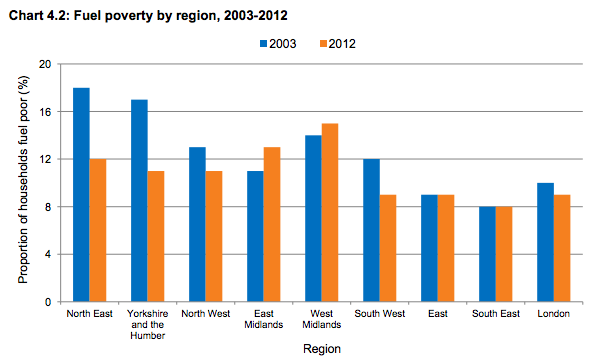 Though the proportion of fuel poor households in London is estimated to be lower than most other regions it can also be seen from graph above (copied from the report) that London has seen a much smaller drop across the decade in the number of fuel poor homes than other regions.
Though the proportion of fuel poor households in London is estimated to be lower than most other regions it can also be seen from graph above (copied from the report) that London has seen a much smaller drop across the decade in the number of fuel poor homes than other regions.
The key data breakdown for London is set out in a separate spreadsheet document – the ‘2012 sub-regional fuel poverty data: low income high costs indicator‘. The data includes a local authority breakdown of data and reports that Newham has the highest incidence of fuel poverty in London with close to 1 in 7 homes deemed to be fuel poor, followed by Harrow, Brent and Waltham Forest.
Table 3 of the dataset breaks down the local authority data further to ‘Lower Super Output Area’. Data on fuel poor households by London Parliamentary constituencies is also provided.
‘Fuel Poverty Trends 2003-12’ provides long term trends under the new Low Income High Costs (LIHC) indicator including a time series on number of households estimated to be fuel poor. The data for London is copied below and indicates that the proportion of London households in fuel poverty initially dipped in the early party of the century, but has increased again, hitting a maximum of 13.2% in 2010, before falling again slightly.
The ‘Fuel Poverty Detailed Tables‘ provide limited regional information, but provided data on fuel poverty by housing type, age of residents, age of dwelling, energy efficiency of dwelling, working status, tenure etc. An additional indicators note is also available here.
40 ESCO deals signed through RE:FIT programme
June 2014: A response by the Mayor to a question this month provides details that, of the 125 public sector organisations working with the RE:FIT programme, 40 have so far signed energy service deals through the GLA’s RE:FIT procurement framework. Local authorities signed up to RE:FIT include Harrow, Ealing, Sutton, Enfield, Merton and Camden. A full list of the 40 organisation is provided here (though, confusingly, a few organisations are mentioned more than once – so not it’s not clear if the list is less than 40 – or these organisations have signed more than one deal with an ESCO partner…?).
Posted in Energy Efficiency, News
Tagged Brent, Buildings, Camden, Ealing, Enfield, Hammersmith and Fulham, Harrow, Kingston, Merton, Newham, RE:FIT, Richmond, Sutton, Waltham Forest
Leave a comment
British Gas data on energy efficiency retrofits in London
June 2014: Following an extensive evidence session on the Mayor’s domestic energy efficiency programme earlier this year – details of which are here – the Mayor has provided some additional information on work being undertaken by British Gas in London.
The letter states that “British Gas, with its London borough and housing association partners, has already committed to invest in excess of £36 million through eight schemes in London shown in the table below.
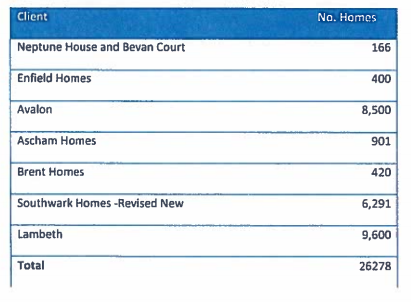 “These schemes are expected to deliver measures to over 26,000 homes across London.” British Gas has previously stated that they would earmark specific funding to London under the Energy Company Obligation (ECO) programme: how much this level has changed following the alternations to ECO proposed by government in their recent ECO consultation is not clear, but has been raised in a recent mayoral question.
“These schemes are expected to deliver measures to over 26,000 homes across London.” British Gas has previously stated that they would earmark specific funding to London under the Energy Company Obligation (ECO) programme: how much this level has changed following the alternations to ECO proposed by government in their recent ECO consultation is not clear, but has been raised in a recent mayoral question.
Posted in Energy Efficiency, News
Tagged Brent, ECO, Energy Efficiency, Enfield, Lambeth, Southwark
Leave a comment
Energy efficiency programme for London’s ‘Cultural & Heritage’ sector
June 2014: The Mayor’s non-domestic energy efficiency programme, RE:FIT, recently held an event focused on improving the energy performance London’s Cultural & Heritage buildings. Presentations were provided by RE:FIT participants the Royal Botanic Gardens, Kew and Millfield Theatre, who undertook their RE:FIT project through the London Borough of Enfield. Details of the event can be read here – and an article on green improvements made at the Lyric Hammersmith theatre, who plan to work with the RE:FIT programme shortly, can be see here.
Seperately, the always innovative Arcola Theatre was profiled as a case study in the government’s recent solar energy strategy for their work on using solar PV together with energy storage technology (see page 48 of the strategy document here).
Posted in Energy Efficiency, News, Renewable Energy
Tagged Buildings, Enfield, Hackney, Hammersmith and Fulham, Photovoltaics, RE:FIT, Richmond
Leave a comment
Mayor sets out serious concerns over ECO proposals
June 2014: The government announced a review of its ECO (Energy Company Obligation) programme in December 2013, against a backdrop of considerable media coverage, across many months, on the rising costs of consumers’ energy bills – all of which culminated in the Prime Minister’s alleged ‘cut the Green Crap‘ quote .
The ECO sets a legal obligation on energy suppliers to provide a reduction in carbon emissions through supporting the uptake of energy efficiency measures in the domestic sector. Each supplier (effectively the ‘Big 6’) has a specific target assigned to it by government depending on the number of domestic gas and electricity customers they supply. The ECO is paid for through a charge on all household energy bills – which is then collected by suppliers and is in turn used by them to help subsidise energy efficiency programmes – such as reduced cost insulation measures. Each household is estimated to pay around £50 a year to pay for ECO (approximately – it depends on the level of charge passed on by the supplier to their customer to meet the costs of their ECO target), which amounts to around £1.3bn a year total ECO spend. The proposals put forward in ECO consultation, with reductions in supplier target levels, and ‘stretching out’ of the targets to March 2017 (see below), are thought to reduce the cost of ECO to households by £30-35 ie a small reduction in energy bills (around 2% against an average energy bill of £1,300) – but also an overall reduction in the amount of money going to fund the government’s main efficiency programme. It should be noted that predecessor ‘supplier obligation’ programmes have operated in the UK since the mid-90s (EESoP, EEC, CERT, CESP) and have contributed significantly to helping improve the energy efficiency of UK homes (see section 6.13 of latest DCLG English Housing Survey report here).
Following the December press release, a consultation paper – the ‘Future of the ECO‘ – was released on 5 March, which closed for comments on April 16th. The consultation set out a wide number of proposals – of which the major ones were to:
- Extend the operation of ECO beyond the current March 2015 deadline to March 2017
- Set new targets for the three sub-obligation targets (CERO, CSCO and HHCRO)
- Reduce the major sub-target of the ECO – the Carbon Emissions Reduction Obligation (CERO) – target by 33 per cent.
The Mayor has posted his response to the government’s proposals highlighting a number of key concerns including that:
Posted in Energy Efficiency, News
Tagged ECO, Energy Efficiency, Fuel Poverty, Solid Wall Insulation
Leave a comment
Barts links energy saving to patient care and saves £105,000 in first year
May 2014: Guardian article on how St Bartholomew’s (Barts) and the Royal London Hospital in London wanted to cut a £12m annual energy bill. “The trust involved three external partners: behavioural change experts Global Action Plan, technology pioneers GE and facilities management specialists Skanska. Each has sustainability at the heart of its rationale and they set about involving employees in two of the trust’s six hospitals in behavioural changes. By concentrating less on the energy message and more on the provision of care, the campaign won the support of staff and saved more than £100,000 and the equivalent of 800 tonnes of CO2 in its first year.“
Further details are set out on Global Action Plan’s website here and here.



